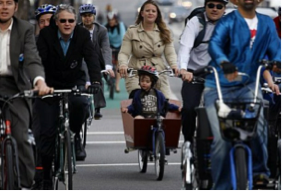
“Every time I see an adult on a bicycle I no longer despair for the future of the human race.” ~ H.G. Wells
It appears that just about everyone is Sydney is critical of our Lord Mayor for the expense she has incurred in making active transportation to and from the city more accessible. Motorists are unhappy because of the congestion that the bikes have caused as well as the need to share the road with cyclists.
Active Transport Effects
There appears a direct relationship between countries that have an active transport culture and lower obesity levels as measured by BMI (>30kg.m2). The lower obesity levels have also been found in states and cities in the US that provide opportunities for active transportation. The cities that generally have the highest active transport numbers are the older cities that have a mixture of residential, commercial and public buildings.
Those countries that rely on motorized transport as their main mode of movement usually demonstrate higher levels of obesity. In these countries active travel is habitual and an important part of life. Interestingly while participation in leisure time activities is lower in lower socio economic groups the reverse has been reported for active transport. This maybe due to the fact that with less disposable income the only method for getting around is to walk, cycle or use public transport. Other groups that are less likely to use active transportation include women, adolescent females and older adults.
In the Netherlands there is approximately 19,000kms of bicycle paths with the average Dutch person cycling about 909kms per year, 30% of all people commute by bicycle, 18% walk, 5% use public transport, while 45% still use motorized transportation. There is 9.1% more bicycles that people with numbers exceeding 18 million, while the population is 16.5 million!
The Top 10
The top 10 bicycle riding countries in the world are Netherlands, Denmark, Germany, Sweden, Norway, Finland, Japan, Switzerland, Belgium and China. Interestingly some of these countries have very inhospitable climates yet the number of cycling journeys appears not be affected to any degree.
At Home
In Australia the trend to more motorized transport rose between 1976-1996, followed by a modest leveling off between 1996-2001 and then a rise again from 2001″â2006. Besides an improvement in health and fitness an increase in active transportation also has significant environmental and personal financial implications. For example, motor vehicle expenses account for the second highest household expenditure for families, behind food and alcoholic beverages. Only 10% of the Australian population do not own a motor vehicle.
The choice to use active transport in Australia is hindered by public policies and corporate incentives that have previously favored motor vehicle use over other forms of transport. The intensity of active transport usually falls into the moderate category. Yet when performed consistently over a long period of time can result in substantial energy expenditure.
When comparisons are made across countries the US has the lowest transportation rates while Latvia reported the highest. Based on body fat measurements the lowest rates of obesity are found in Sweden (9.4%), Switzerland (8%) and Netherlands (8.1%) where active transport is reportedly the highest. The highest obesity rates are found in the US at 34.3% where the lowest rates of active transport are also reported. These figures continually support the notion that countries that are reliant on motorized transport have the highest obesity levels.
China as an emerging super power has been developing an increased reliance on motor vehicles over the past 25 years with over14% of Chinese households now owning a motor vehicle. Due to the increased ownership and use of motorized transport rapidly taking over from cycling as a main form of transport, Chinese men who now own a car have gained on average 1.8 kg in body-weight after its purchase. This indicated that these men were twice as likely to become obese compared to those who did not own a motor vehicle.
Consequences
It is possible that each hour spent driving a motor vehicle increases the likelihood of gaining weight by 6% while each additional kilometer walked per day is associated with 5% reduction in the likelihood of weight gain. Given that many people have difficulty in starting or maintaining a formal exercise program it is possible that active transportation could possibly meet the minimum recommended national physical activity guidelines.
In 2008, a report by the European Directorate for Energy and Transport stated that Europeans walked three times further than Americans and covered nearly double the cycling distances. Simple conversions might roughly equate energy expenditure in Europeans to be between 48-83 calories per day compared to 20 calories per day for the Americans.















